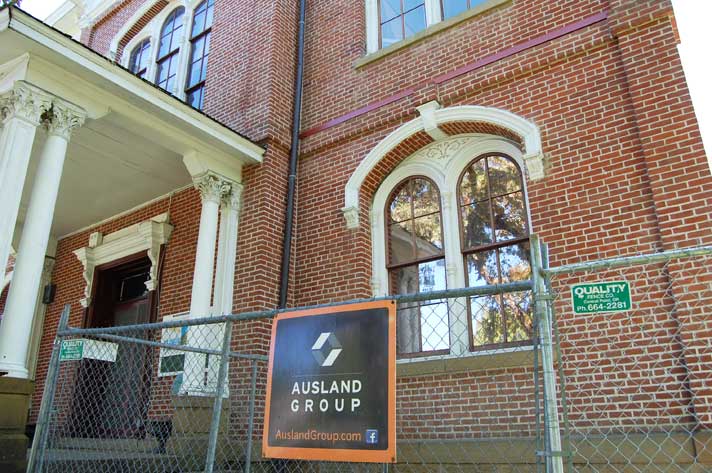Ausland Group is just a few days away from completing the seismic upgrades on the historic Jacksonville Courthouse.
This seismic renovation includes installing brackets and hardware to the original wood joists and anchoring them to the existing masonry walls to reinforce and strengthen the building and prevent the floors and roof from possible collapse in case of a seismic event.
“We’re so excited to have been able to partner with the City of Jacksonville on this project,” Kelsy Ausland, P.E., President of Ausland Group, stated.
Standing tall and proud since 1883, the Courthouse has long served as the start to Jacksonville’s historic core. It was formerly occupied by the Jacksonville Museum and the Southern Oregon Historical Society until it was gifted from Jackson County to the City of Jacksonville in 2012.
When it came time to decide who could help keep the Courthouse standing strong for another 130 years, Ausland Group was the perfect fit.
Owned by Aaron and Kelsy Ausland, and specializing in historic renovation projects, Ausland Group has being providing engineering and construction services throughout the Pacific Northwest for 67 years. When the City of Jacksonville decided to move forward with renovations to turn the Courthouse into the New City Hall, Ausland Group was ready to take on the challenge.
“Our team is passionate about historic projects,” Ausland said, “and we are honored to use our technical skills to keep history alive.”
Ausland’s historic restoration team includes leader Greg Ausland, P.E., V.P. of Design, and a structural engineering team, who together has over 100 years of combined engineering experience. Passionate about historic preservation, Greg Ausland has had the distinctive experience of being the project manager on numerous award-winning projects, including the historic restoration of 33 covered bridges in Oregon.
The challenge to retrofitting any historic building is to strengthen it, while maintaining the historic character of the building itself. No stranger to working on historical buildings, the Ausland Group, based in Grants Pass, has also successfully completed multiple renovation projects, including the Applegate Elementary School, Oregon Caves National Monument Chateau, Britt Festivals Gardens, Oregon Shakespeare Festival “The Bricks,” and Southern Oregon University’s Churchill Hall. They credit their success to their culture of advocacy and the strong team they have established.
“It is critical to have the right team on board. Updating historic structures requires striking a balance between retaining original building features and accommodating new technologies and equipment,” Ausland stated, “Accommodating new functions, changes in technology and improved standards of protection provide challenges to the reuse of historic buildings and sites.”
The seismic renovations are being delivered with a team approach that provided a 30% savings over other craftsmen in the area.
Like many of the historic buildings in Oregon, the Jacksonville Courthouse didn’t meet the seismic building code standards required today. Built in 1883, and listed on the National Register of Historic Places, it is classified as an unreinforced masonry building, which is a brick building constructed without steel reinforcements, ties and connections required by modern building codes. Although the courthouse was built with high-quality materials, because the walls are not tied to the floors and ceiling they could collapse during an earthquake.
While Jacksonville has never been hit with a significant seismic event, the last several years have shown that similar buildings on the West Coast are extremely vulnerable to seismic activity.
In 2001, many buildings damaged after the Nisqually earthquake hit Seattle with a magnitude of 6.8 were built with unreinforced masonry, similar to the Jackson county courthouse. While there were no casualties, people were injured and property was damaged by falling bricks.
The San Simeon earthquake of 2003 had a magnitude of 6.6 off the Central Coast of California, damaging multiple unreinforced masonry buildings, including the Acorn Building, which completely collapsed, resulting in two fatalities.
There are thousands of unreinforced masonry buildings in the California Bay Area that have not been retrofitted, and in 2014, Napa suffered a 6.0 earthquake that damaged several of these types of structures, while the historic buildings that had been retrofitted performed as expected, surviving without major damage.
While Oregon has never experienced the frequency or magnitude of earthquakes compared to California, that doesn’t mean we aren’t at risk. A detailed study* of the Cascadia Fault confirms that the region has had frequent earthquakes over the past several thousand years. Based on these recurrences, there is a high probability that Oregon will experience a major earthquake. The potential damage caused by unreinforced masonry buildings collapsing could pose a significant risk to the community.
With the seismic retrofit almost complete, the Jacksonville Courthouse renovation is one step closer to completion, and while it will be providing a home for the Jacksonville City Offices, there is great potential for additional public uses in the future.
“The Jacksonville Courthouse was built to serve the community,” Ausland stated, “and we’re proud to ensure it’s here for generations to come.”
Ausland offers complete capital improvement expertise in development consulting, engineering and construction. For more information visit them at auslandgroup.com.
*Robert Kayen (ed), “Turbidite Event History-Methods and Implications for Holocene Paleoseismicity of the Cascadia Subduction Zone,” January 14, 2013, http://pubs.usgs.gov/pp/pp1661f/.
